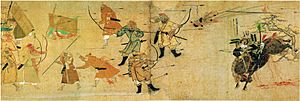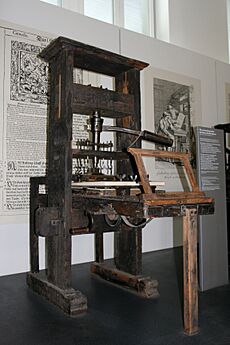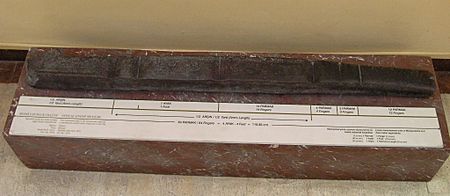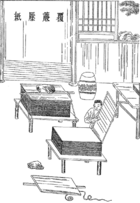Timeline of historic inventions facts for kids
The timeline of amazing inventions is a list of really important and cool inventions and the people who created them, if we know who they are! It shows how humans have always been inventing new things to make life better.
Contents
Ancient Times: Stone Age to Iron Age
This section covers inventions from the very first stone tools up to the Iron Age. The dates here are when archaeologists first found proof of these inventions. These dates can change as new discoveries are made.
Early Stone Age (Lower Paleolithic)
This time period lasted over 3 million years! Many early human-like species lived then, including Homo sapiens later on. During this time, the Earth also went through many ice ages.
- 3.3 to 2.6 million years ago: Stone tools were first used in what is now Kenya. These were simple tools made by early human relatives.
- 2.3 million years ago: Early humans, like Homo habilis, probably learned to control fire and start cooking.
- 1.76 million years ago: More advanced stone tools were made in Kenya by Homo erectus.
- 1.5 million years ago: Homo erectus in Africa started using Bone tools.
- 900,000 to 40,000 years ago: Early Boats were likely used.
- 500,000 years ago: Homo heidelbergensis in South Africa learned Hafting, which means attaching stone tools to handles.
- 450,000 to 500,000 years ago: Early Woodworking and construction happened in Zambia by Homo heidelbergensis.
- 400,000 years ago: Pigments (colors for painting) were used in Zambia by Homo heidelbergensis.
- 400,000 to 300,000 years ago: Spears were used in Germany, probably by Homo heidelbergensis.
Middle Stone Age (Middle Paleolithic)
This period began around 300,000 years ago, when Homo sapiens (modern humans) first appeared. Humans started moving out of Africa and began trading over long distances. They also started having religious ceremonies and creating art.
- 320,000 years ago: People in Kenya started trading and moving resources like obsidian over long distances. They also used pigments and possibly made projectile weapons.
- 279,000 years ago: Early stone-tipped projectile weapons were made in Ethiopia.
- 200,000 years ago: Simple glue was made from birch tar by Neanderthals in Italy.
- 200,000 years ago: The first beds were used in South Africa.
- 170,000 to 83,000 years ago: Clothing was worn by modern humans in Africa.
- 135,000 to 100,000 years ago: Beads were made in Israel and Algeria.
- 100,000 years ago: Complex paints were created in South Africa.
- 100,000 years ago: The first burials (funerals) took place in Israel.
- 90,000 years ago: Harpoons were used in the Democratic Republic of the Congo.
- 70,000 to 60,000 years ago: In Sibudu Cave in South Africa, Homo sapiens invented:
- Compound adhesives (stronger glues).
- Arrows and bow-and-arrow technology.
- The Sewing needle.
- 61,000 to 62,000 years ago: Cave paintings were made in Spain by Neanderthals.
- 55,800 to 51,200 years ago: Early Narrative art (art that tells a story) appeared in Indonesia by Homo Sapiens.
Late Stone Age (Upper Paleolithic to Early Mesolithic)
This period, starting around 50,000 years ago, saw a big jump in human behavior. People started having more religious practices, artistic expression, and tools made for thinking or art.
- 49,000 to 30,000 years ago: Ground stone tools, like axe fragments, appeared in Australia.
- 47,000 years ago: The oldest known mines were in Eswatini, where people dug for hematite to make red ochre pigment.
- 45,000 to 9,000 years ago: Early evidence of shoes comes from China. The oldest actual shoes found are bark sandals from 10,000 to 9,000 years ago in the United States.
- 44,000 to 42,000 years ago: Tally sticks (for counting) were used in Eswatini.
- 42,000 years ago: The Flute was invented in Germany.
- 37,000 years ago: The Mortar and pestle were used in Southwest Asia.
- 32,000 to 28,000 years ago: Rope and cords were used for things like attaching tools or making baskets.
- 31,000 years ago: Early Amputation and surgery were performed.
- 28,000 years ago: Ceramics (pottery) and weaving (seen from impressions in pottery) were made in the Czech Republic and Georgia.
- 24,000 years ago: The oldest known ceramic sculpture, the Venus of Dolní Věstonice, was created.
- 23,000 years ago: The dog was first tamed in Siberia.
- 22,000 years ago: The Fish hook was invented in Okinawa Island, Japan.
- 21,000 to 3,700 years ago: Early Star charts were made in France and other places.
- 17,500 years ago: The Spear-thrower (atlatl) was found in France.
- 16,000 years ago: Pottery was made in China.
- 14,500 years ago: Bread was made in Jordan.
Farming and Early Civilizations
The end of the last ice age, around 11,700 years ago, led to the Agricultural Revolution. This was a huge change as people started farming and settling down.
New Stone Age (Neolithic) and Late Middle Stone Age (Late Mesolithic)
During the Neolithic period, which lasted about 8,400 years, stone was still important for tools, but people also started using copper and early bronze. Many animals and plants were domesticated.
- 10,000 to 9,000 BC: Agriculture began in the Fertile Crescent (Middle East).
- 10,000 to 9,000 BC: Sheep were first tamed in Southwest Asia, followed by pigs, goats, and cattle.
- 9500 to 9000 BC: The oldest known building still standing is Göbekli Tepe in Turkey.
- 9000 to 6000 BC: Rice was first farmed in China.
- 9000 BC: Mudbricks (unfired bricks) and clay mortar were used in Jericho.
- 8400 BC: The oldest known water well was found in Cyprus.
- 8000 to 7500 BC: Large permanent settlements, like Tell es-Sultan (Jericho) and Çatalhöyük in Turkey, became early cities.
- 7000 BC: Alcohol fermentation, specifically mead (an alcoholic drink), was made in China.
- 7000 BC: Sled dogs and dog sleds were used in Siberia.
- 7000 to 3300 BC: Tanned leather was made in Mehrgarh, Pakistan.
- 6500 BC: Evidence of lead smelting (extracting lead from ore) was found in Çatalhöyük, Turkey.
- 6000 BC: The Kiln (an oven for baking pottery) was invented in Mesopotamia (Iraq).
- 6th millennium BC: Irrigation (watering crops) was used in Khuzistan, Iran.
- 6000 to 3200 BC: Early forms of writing appeared in Egypt, Iraq, and other places.
- 5500 to 5200 BC: The oldest evidence of cheese was found in Poland and Croatia.
- 5500 BC: Sailing was depicted on pottery in Mesopotamia and later in ancient Egypt.
- 5000 BC: Copper smelting began in Serbia.
- 5000 BC: A Seawall was built in Tel Hreiz.
- 5th millennium BC: Lacquer was used in China.
- 5000 BC: Cotton thread was found in Mehrgarh, Pakistan.
- 5000 to 4500 BC: Rowing oars were used in China.
- 4650 BC: Early copper-tin bronze was found in Serbia.
- 4500 to 3500 BC: Lost-wax casting (a way to make metal sculptures) was used in Israel or the Indus Valley.
- 4400 BC: Fired bricks were made in China.
- 4000 BC: The first diamond mines probably existed in Southern India.
- 4000 BC: Paved roads were found around the city of Ur, Iraq.
- 4000 BC: Plumbing systems, with clay pipes, were found at the Temple of Bel in Babylonia.
- 4000 BC: The oldest evidence of locks was found in Nineveh, Assyria.
- 4000 to 3400 BC: The oldest evidence of wheels was found in Ukraine, Poland, and Germany.
- 3630 BC: Silk garments (sericulture) were made in China.
- 3500 BC: The horse was probably first tamed in the Eurasian Steppes.
- 3500 BC: Wine was used as general anaesthesia in Sumer.
- 3500 BC: The seal (for marking things) was invented in the Near East.
- 3500 BC: Ploughing (tilling the soil for farming) was done in the Czech Republic.
- 3400 to 3100 BC: Tattoos were found in southern Europe.
Bronze Age
The Bronze Age began when people learned to make bronze. This time also saw the rise of the first cities and writing.
- Late 4th millennium BC: Writing systems developed in Sumer and Egypt.
- 3300 BC: The first documented swords, made of arsenical bronze, were found in Arslantepe, Turkey.
- 3300 BC: The first City was Uruk in Sumer, Mesopotamia (modern-day Iraq).
- 3250 BC: One of the earliest known hats was worn by Ötzi, the Iceman, found frozen in the Alps.
- 3200 BC: Dry Latrines were used in Uruk, Iraq.
- 3200 BC: The earliest actual wheel ever found, made of wood, was discovered in Slovenia.
- 3000 BC: Devices like dice were seen in the Egyptian game of Senet.
- 3000 BC: Tin was extracted in Central Asia.
- 3000 to 2560 BC: Papyrus (an early form of paper) was used in Egypt.
- 3000 BC: A Reservoir (for storing water) was built in Girnar, India.
- 3000 BC: Receipts were used in Ancient Mesopotamia.
- 3000 to 2800 BC: The first Prosthesis (artificial body parts), like an eye, were documented in ancient Egypt and Iran.
- 3000 to 2500 BC: Rhinoplasty (nose surgery) was performed in Egypt.
- 2650 BC: The Ruler, or Measuring rod, was used by the Sumerian Civilisation in Iraq.
- 2600 BC: Planned cities were built in the Indus Valley (India, Pakistan).
- 2600 BC: Public sewage and sanitation systems were found in Indus Valley sites like Mohenjo-daro.
- 2600 BC: A Public bath was built in Mohenjo-daro, Pakistan.
- 2600 BC: Levees (embankments to prevent flooding) were used in the Indus Valley.
- 2600 BC: Balance weights and scales were used in Ancient Egypt.
- 2556 BC: Docks were built in Wadi al-Jarf, Egypt.
- 2500 BC: Puppetry existed in the Indus Valley.
- 2400 BC: The Fork was used in China.
- 2400 BC: Copper pipes were found in the Pyramid of Sahure in Egypt.
- 2400 BC: The touchstone (for testing metals) was used in the Indus Valley.
- 2300 BC: The first Dictionary was created in Mesopotamia.
- 2200 to 2000 BC: Iron smelting (extracting iron from ore) began in Kaman-Kalehöyük.
- 2200 BC: A Protractor (for measuring angles) was found in Lothal, India.
- 2000 BC: The Water clock was used in Babylonia.
- 2000 BC: The Chariot was used in Russia and Kazakhstan.
- 2000 BC: The Fountain was invented in Lagash, Sumer.
- 2000 BC: Scissors were used in Mesopotamia.
- 1850 BC: The first alphabet, the Proto-Sinaitic script, appeared in Egypt.
- 1600 BC: A Surgical treatise (medical text) appeared in Egypt.
- 1500 BC: The Sundial was used in Ancient Egypt or Babylonia.
- 1500 BC: Glass was manufactured in Mesopotamia or Ancient Egypt.
- 1500 BC: The Seed drill (for planting seeds) was used in Babylonia.
- 1500 BC: A Prosthetic limb was mentioned in ancient Indian texts.
- 1400 BC: Rubber was used in Mesoamerica for ballgames.
- 1400 to 1200 BC: Early Concrete was used in Greece.
- 1300 BC: The Lathe (a machine for shaping materials) was used in Ancient Egypt.
- 1200 BC: Distillation (for separating liquids) was described in Akkadian texts.
Iron Age
The Iron Age began around 1200 BC after the collapse of many Bronze Age cultures. Iron became the main material for tools and weapons.
- 1100 BC: The first Star catalogues were created in Babylonia.
- 700 BC: The Saddle (for riding horses) was used by Assyrian cavalry.
- 7th century BC: The royal Library of Ashurbanipal in Nineveh had a library catalog to organize its 30,000 clay tablets.
- 688 BC: Waterproof concrete was used by the Assyrians.
- 650 BC: The Crossbow was invented in China.
- 650 BC: Windmills were used in Persia.
- 600 BC: Coins were invented in Phoenicia or Lydia.
- Late 7th or early 6th century BC: The Wagonway called Diolkos was built across the Isthmus of Corinth in Ancient Greece.
- 6th century BC to 10th century AD: High Carbon Steel, known as Wootz steel, was produced in South India.
- 6th century BC: The first University was in Taxila, India.
- 6th to 2nd century BC: Advanced medicine and surgery were developed in India, including:
- Late 6th century BC: The crank mechanism was used in Carthage and Spain.
- Before 5th century BC: Loan deeds (agreements for loans) were used in India.
- 500 BC: The Lighthouse was invented in Greece.
Classical and Medieval Times
5th century BC
- 500 to 200 BC: The Toe stirrup was depicted in Buddhist art in India.
- 485 BC: The Catapult and scythed chariot were invented by Ajatashatru in Magadha, India.
- 5th century BC: Cast iron was developed in Ancient China.
- 480 BC: Spiral stairs were built in Selinunte, Sicily.
- By 407 BC: Early descriptions of a Wheelbarrow appeared in Greece.
- By 400 BC: The Camera obscura (a device for projecting images) was described by Mo-tzu in China.
4th century BC
- 4th century BC: The Traction trebuchet (a type of catapult) was used in Ancient China.
- 4th century BC: Gears were used in Ancient China.
- 4th century BC: Reed pens, with a split tip, were used to write with ink on Papyrus in Egypt.
- 4th century BC: Nailed Horseshoes were found in an Etruscan tomb.
- 375 to 350 BC: The Horse mill (an animal-driven grinding machine) was used in Carthage.
- By the late 4th century BC: Early Corporations existed in India or Ancient Rome.
- Late 4th century BC: The Cheque was used in the Maurya Empire of India.
- 4th to 3rd century BC: Zinc production began in North-Western India.
3rd century BC
- 3rd century BC: Early analog computers, like the Antikythera mechanism, were made in the Hellenistic world.
- By at least the 3rd century BC: Archimedes' screw, a machine for lifting water, was used for irrigation in Ancient Egypt.
- Early 3rd century BC: The Canal lock (for raising and lowering boats in canals) was used in Hellenistic Egypt.
- 3rd century BC: The cam mechanism was used in water-driven machines during the Hellenistic period.
- By the 3rd century BC: The Water wheel was used.
- 3rd century BC: The Gimbal (a device that allows an object to rotate freely in any direction) was described by Philo of Byzantium.
- Late 3rd century BC: The Dry dock (for repairing ships) was used in Hellenistic Egypt.
- 3rd to 2nd century BC: The Blast furnace (for making iron) was used in Ancient China.

2nd century BC
- 2nd century BC: Paper was invented in Han dynasty China.
- 206 BC: The Compass was invented in Han dynasty China.
- Early 2nd century BC: The Astrolabe (an instrument for measuring the positions of stars) was invented by Apollonius of Perga.
1st century BC
- 1st century BC: Segmental arch bridges were built in Italy by the Roman Republic.
- 1st century BC: Early News bulletins were used during the reign of Julius Caesar.
- 1st century BC: The Arch dam was built in Gallia Narbonensis by the Roman Republic.
- Before 40 BC: The Trip hammer (a power hammer) was used in China.
- 37 to 14 BC: Glass blowing was developed in Jerusalem.
- Before 25 BC: The Reverse overshot water wheel was used by Roman engineers in Spain.
- 25 BC: Noodles were found in Lajia in China.
1st century AD
- 1st century AD: The aeolipile, a simple steam turbine, was recorded by Hero of Alexandria.
- 1st century AD: Early respiratory protective equipment was used in Roman mines.
- 1st century AD: The oldest surviving wine was made.
- 1st century AD: Vending machines were invented by Hero of Alexandria.
- By the 1st century AD: The double-entry bookkeeping system was used in the Roman Empire.
2nd century AD
- 132 AD: The Seismometer (for detecting earthquakes) and pendulum were invented in Han dynasty China by Zhang Heng.
- 2nd century AD: Carding (for preparing fibers) was done in India.
3rd century AD

- By at least the 3rd century AD: Crystallized sugar was made in India.
- Early 3rd century AD: Woodblock printing was invented in Han dynasty China.
- Late 3rd to Early 4th century AD: The Water turbine was used in the Roman Empire in modern-day Tunisia.
4th century AD
- 280 to 550 AD: Chaturanga, an early form of Chess, was invented in India.
- 4th century AD: Roman Dichroic glass, which changes color depending on the light, was created.
- 4th century AD: The Mariner's compass was mentioned in Tamil texts in Southern India.
- 4th century AD: The Simple suspension bridge was independently invented in South America and the Hindu Kush mountains.
- 4th century AD: The Fishing reel was mentioned in Chinese writings.
- 347 AD: Oil Wells and Borehole drilling were done in China.
- 4th to 5th century AD: The Paddle wheel boat was described in the Roman Empire.
5th century AD
- 400 AD: The Iron pillar of Delhi in India showed advanced rust-resistant iron making.
- 5th century AD: The horse collar was developed in China.
- 5th to 6th century AD: The Pointed arch bridge was built in the Eastern Roman Empire.
6th century AD
- By the 6th century AD: The Incense clock was used in China.
- After 500 AD: The Charkha (spinning wheel) was invented in India.
- 563 AD: The Pendentive dome (like in Hagia Sophia) was built in Constantinople.
- 577 AD: Sulfur matches existed in China.
- 589 AD: Toilet paper was first mentioned in Sui dynasty China.
7th century AD
- 619 AD: The Toothbrush was invented in China during the Tang dynasty.
- 672 AD: Greek fire, an incendiary weapon, was used in Constantinople.
- 7th century AD: Banknotes (paper money) were first developed in Tang dynasty China.
- 7th century AD: Porcelain was manufactured in Tang dynasty China.
9th century AD

- 9th century AD: Gunpowder was discovered by Chinese alchemists in Tang dynasty China.
- 9th century AD: Playing cards were invented in Tang dynasty China.
- 857 to 859 AD: The first degree-granting university was founded in Morocco.
10th century AD
- 10th century AD: The Fire lance, an early firearm, was developed in Song dynasty China.
- 10th century AD: Fireworks first appeared in Song dynasty China.
- 974 AD: The Fountain pen was invented in Arab Egypt.
11th century AD
- 11th century AD: Early versions of the Bessemer process (for making steel) were developed in China.
- 11th century AD: The Endless power-transmitting chain drive was used by Su Song for an astronomical clock.
- 11th century AD: Calico fabric was developed in Calicut, India.
- 1088 AD: Movable type printing was recorded in Song dynasty China by Bi Sheng.
13th century AD
- 13th century AD: Rockets for military and fun uses date back to 13th-century China.
- 13th century AD: The earliest mechanical escapement (for clocks) appeared in Europe.
- 13th century AD: Buttons (with buttonholes) for closing clothes appeared in Germany.
- 13th century AD: The Explosive bomb was used in Jin dynasty Manchuria.
- 13th century AD: The Hand cannon was used in Yuan dynasty China.
- 13th century AD: Early snow goggles were used by Inuit people.
- 13th to 14th century AD: The Worm gear cotton gin was used in India.
- 1277 AD: The Land mine was used in Song dynasty China.
- 1286 AD: Eyeglasses were invented in Italy.
14th century AD
- Early to Mid 14th century AD: The Multistage rocket was described in Ming dynasty China.
- By at least 1326 AD: The Cannon was used in Ming dynasty China.
- 14th century AD: Painting Canvas was first used in Italy.
- 14th century AD: Jacob's staff (for navigation) was described by Levi ben Gerson.
- 14th century AD: The Naval mine was mentioned in Ming dynasty China.
- 14th century AD: Bidriware (a metal craft) was made in India.

15th century AD
- Early 15th century AD: The Coil spring was invented in Europe.
- 15th century AD: The Mainspring (for clocks) was invented in Europe.
- 15th century AD: The Rifle was invented in Europe.
- 1420s: The brace (a hand tool) was invented in Flandres.
- 1439 AD: The Printing press was invented in Mainz, Germany by Johannes Gutenberg.
- Mid 15th century AD: The Arquebus (an early type of gun) was invented.
- 1480s: The Mariner's astrolabe was used by Portuguese explorers.
Early Modern Era
16th century
- 16th century: Chintz (printed clothing) was made in India.
- 16th century: The Hookah was invented in India.
- 1560: The Floating Dry Dock was invented in Venice.
- 1569: The Mercator Projection map was created by Gerardus Mercator.
- 1589: The Stocking frame (for knitting) was invented by William Lee.
- 1594: The Backstaff (for navigation) was invented by Captain John Davis.
- By at least 1597: The Revolver was invented by Hans Stopler.
17th century

- 1605: The first Newspaper, Relation, was published by Johann Carolus.
- 1608: The Telescope was invented.
- 1620: Compound microscopes appeared in Europe.
- 1630: The Slide rule was invented by William Oughtred.
- 1642: The Mechanical calculator, the Pascaline, was built by Blaise Pascal.
- 1643: The Barometer (for measuring air pressure) was invented by Evangelista Torricelli.
- 1650: The Vacuum pump was invented by Otto von Guericke.
- 1656: The Pendulum clock was invented by Christiaan Huygens.
- 1663: The Friction machine was invented by Otto von Guericke.
- 1668: The first working reflecting telescope was built by Isaac Newton.
- 1679: The Pressure-cooker was invented by Denis Papin.
- 1680: Christiaan Huygens described the first piston engine.
- 1698: Thomas Savery developed a steam-powered water pump for draining mines.
18th century
1700s
- 1709: Bartolomeo Cristofori crafted the first piano.
- 1709: Daniel Gabriel Fahrenheit invented the alcohol thermometer.
1710s
- 1712: Thomas Newcomen built the first commercial steam engine to pump water out of mines.
1730s
- 1730: The octant (for navigation) was developed by Thomas Godfrey and John Hadley.
- 1733: John Kay invented the flying shuttle, making looms easier to operate.
- 1738: Lewis Paul and John Wyatt invented the first mechanized cotton spinning machine.
1740s
- 1742: Benjamin Franklin invented the Franklin stove.
- 1745: The Leyden jar, an early form of capacitor, was developed by Musschenbroek and Kleist.
- 1746: John Roebuck invented the lead chamber process for making sulfuric acid.
1750s
- 1752: Benjamin Franklin invented the lightning rod.
- 1755: William Cullen invented the first artificial refrigeration machine.
1760s
- 1760: John Joseph Merlin invented the first Roller skates.
- 1764: James Hargreaves invented the spinning jenny.
- 1765: James Watt invented an improved steam engine with a separate condenser.
- 1767: Joseph Priestley invented a method for making carbonated water.
- 1769: Nicolas-Joseph Cugnot invented the first steam-powered vehicle, an early car.
1770s
- 1770: Richard Salter invented an early design for a weighing scale.
- 1774: John Wilkinson invented his boring machine, an early machine tool.
- 1775: Jesse Ramsden invented the modern screw-cutting lathe.
- 1776: John Wilkinson invented a mechanical air compressor.
- 1778: Robert Barron invented the first lever tumbler lock.
1780s
- 1780: Hyder Ali of India developed the first metal-cylinder rockets.
- 1783: Claude de Jouffroy built the first steamboat.
- 1783: The Montgolfier brothers built the first manned hot air balloon.
- 1783: Louis-Sébastien Lenormand invented and used the first modern parachute.
- 1785: Martinus van Marum was the first to use the electrolysis technique.
- 1786: Andrew Meikle invented the threshing machine.
- 1789: Edmund Cartwright invented the power loom.
1790s
- 1790: Thomas Saint invented the sewing machine.
- 1792: Claude Chappe invented the modern semaphore telegraph.
- 1793: Eli Whitney invented the modern cotton gin.
- 1795: Joseph Bramah invented the hydraulic press.
- 1796: Alois Senefelder invented the lithography printing technique.
- 1797: Samuel Bentham invented plywood.
- 1799: George Medhurst invented the first motorized air compressor.
- 1799: The first paper machine was invented by Louis-Nicolas Robert.
Late Modern Period
19th century
1800s
- 1800: Alessandro Volta invented the voltaic pile, an early battery.
- 1802: Humphry Davy invented the arc lamp.
- 1804: Friedrich Sertürner discovered morphine.
- 1804: Joseph Marie Jacquard developed his automated Jacquard loom.
- 1804: Richard Trevithick invented the steam locomotive.
- 1804: Hanaoka Seishū created the first modern general anesthetic.
- 1807: Nicéphore Niépce invented an early internal combustion engine.
- 1807: François Isaac de Rivaz designed the first automobile powered by an internal combustion engine.
- 1807: Robert Fulton launched the first workable steamboat.
1810s
- 1810: Nicolas Appert invented the canning process for food.
- 1810: Abraham-Louis Breguet created the first wristwatch.
- 1811: Friedrich Koenig invented the first powered printing press.
- 1812: William Reid Clanny invented the safety lamp for mines.
- 1814: James Fox invented the modern planing machine.
- 1816: René Laennec invented the first Stethoscope.
- 1816: Francis Ronalds built the first working electric telegraph.
- 1816: Robert Stirling invented the Stirling engine.
- 1817: Baron Karl von Drais invented the dandy horse, an early bicycle.
- 1818: Marc Isambard Brunel invented the tunnelling shield.
1820s
- 1822: Thomas Blanchard invented the pattern-tracing lathe.
- 1822: Nicéphore Niépce invented Heliography, the first photographic process.
- 1822: Charles Babbage began building the first programmable mechanical computer.
- 1823: Johann Wolfgang Döbereiner invented the first lighter.
- 1824: Johann Nikolaus von Dreyse invented the bolt-action rifle.
- 1824: William Sturgeon invented the electromagnet.
- 1826: John Walker invented the friction match.
- 1826: James Sharp invented the first practical gas stove.
- 1828: James Beaumont Neilson developed the hot blast process for iron making.
- 1828: Patrick Bell invented the reaping machine.
- 1828: Ányos Jedlik invented the first electromechanical machine with electromagnets.
- 1829: Louis Braille invented the Braille reading system for the blind.
- 1829: William Mann invented the compound air compressor.
- 1829: Henry Robinson Palmer patented corrugated galvanised iron.
1830s
- 1830: Edwin Budding invented the lawn mower.
- 1831: Michael Faraday invented a method of electromagnetic induction.
- 1834: Moritz von Jacobi invented the first practical electric motor.
- 1835: Joseph Henry invented the electromechanical relay.
- 1837: Samuel Morse invented Morse code.
- 1838: Moritz von Jacobi invented electrotyping.
- 1839: William Otis invented the steam shovel.
- 1839: James Nasmyth invented the steam hammer.
- 1839: Edmond Becquerel invented a method for the photovoltaic effect, creating the first solar cell.
- 1839: Charles Goodyear invented vulcanized rubber.
- 1839: Louis Daguerre invented daguerreotype photography.
1840s
- 1840: John Herschel invented the blueprint.
- 1841: Alexander Bain devised a printing telegraph.
- 1842: William Robert Grove invented the first fuel cell.
- 1842: John Bennet Lawes invented superphosphate, the first man-made fertilizer.
- 1844: Friedrich Gottlob Keller and Charles Fenerty independently developed the wood pulp method of paper production.
- 1844: Francis Rynd invented the hypodermic needle.
- 1845: Isaac Charles Johnson invented modern Portland cement.
- 1846: Henri-Joseph Maus invented the tunnel boring machine.
- 1847: Ascanio Sobrero invented Nitroglycerin, a stronger explosive than black powder.
- 1848: Jonathan J. Couch invented the pneumatic drill.
- 1848: Linus Yale Sr. invented the first modern pin tumbler lock.
- 1849: Walter Hunt invented the first repeating rifle and the Safety pin.
- 1849: James B. Francis invented the Francis turbine.
1850s
- 1850: William Armstrong invented the hydraulic accumulator.
- 1851: George Jennings offered the first public flush toilets.
- 1852: Robert Bunsen was the first to use a chemical vapor deposition technique.
- 1852: Elisha Otis invented the safety brake elevator.
- 1852: Henri Giffard made the first manned, controlled, and powered flight using a dirigible.
- 1853: François Coignet invented reinforced concrete.
- 1855: James Clerk Maxwell invented the first practical method for color photography.
- 1855: Henry Bessemer patented the Bessemer process for making steel.
- 1856: Alexander Parkes invented parkesine, the first man-made plastic.
- 1856: James Harrison produced the world's first practical ice making machine and refrigerator.
- 1856: William Henry Perkin invented mauveine, the first synthetic dye.
- 1857: Heinrich Geissler invented the Geissler tube.
- 1857: The phonautograph, the earliest known device for recording sound, was invented by Édouard-Léon Scott de Martinville.
- 1859: Gaston Planté invented the lead-acid battery, the first rechargeable battery.
1860s
- 1860: Joseph Swan produced carbon fibers.
- 1864: Louis Pasteur invented the pasteurization process.
- 1865: Carl Wilhelm Siemens and Pierre-Émile Martin invented the Siemens-Martin process for making steel.
- 1867: Alfred Nobel invented dynamite.
- 1867: Lucien B. Smith invented barbed wire.
1870s
- 1872: Polyvinyl chloride (vinyl) was created by Eugen Baumann.
- 1872: Stainless steel was invented by J.E.T. Woods and J. Clark.
- 1873: Frederick Ransome invented the rotary kiln.
- 1873: William Crookes invented the Crookes radiometer.
- 1873: Zénobe Gramme invented the first commercial electrical generator.
- 1874: Gustave Trouvé invented the first metal detector.
- 1875: Fyodor Pirotsky invented the first electric tram.
- 1876: Nicolaus August Otto invented the four-stroke cycle.
- 1876: Alexander Graham Bell was granted a patent for the telephone.
- 1877: Thomas Edison invented the first working phonograph.
- 1878: Henry Fleuss patented the first practical rebreather.
- 1878: Lester Allan Pelton invented the Pelton wheel.
- 1879: Joseph Swan and Thomas Edison both patented a functional incandescent light bulb.
1880s
- 1881: Nikolay Benardos presented carbon arc welding.
- 1884: Hiram Maxim invented the Maxim gun, an early automatic firearm.
- 1884: Paul Vieille invented Poudre B, the first smokeless powder.
- 1884: Sir Charles Parsons invented the modern steam turbine.
- 1884: Hungarian engineers invented the high-efficiency transformer and AC parallel power distribution.
- 1885: John Kemp Starley invented the modern safety bicycle.
- 1886: Carl Gassner invented the zinc–carbon battery, the first dry cell battery.
- 1886: Charles Martin Hall and Paul Héroult independently invented the Hall–Héroult process for producing aluminum.
- 1886: Karl Benz invented the first petrol-powered automobile (car).
- 1887: Carl Josef Bayer invented the Bayer process for producing alumina.
- 1887: James Blyth invented the first wind turbine for electricity.
- 1887: John Stewart MacArthur developed the process of gold cyanidation.
- 1888: John J. Loud invented the ballpoint pen.
- 1888: Thomas Edison and William Kennedy Dickson invented the Kinetoscope.
- 1888: Heinrich Hertz proved the existence of radio waves.
- 1888: The first practical pneumatic tire was made by John Boyd Dunlop.
1890s
- 1890s: Frédéric Swarts invented the first chlorofluorocarbons for refrigeration.
- 1890: Robert Gair invented the pre-cut cardboard box.
- 1891: Whitcomb Judson invented the zipper.
- 1892: Léon Bouly invented the cinematograph.
- 1892: Thomas Ahearn invented the electric oven.
- 1893: Rudolf Diesel invented the diesel engine.
- 1893: William Stewart Halsted invented the rubber glove for medical use.
- 1895: Guglielmo Marconi invented a system of wireless communication using radio waves.
- 1895: Wilhelm Conrad Röntgen invented the first radiograph (x-rays).
- 1897: Surgical masks made of cloth were developed by physicians in Europe.
- 1898: Hans von Pechmann synthesized polyethylene, now the most common plastic.
- 1899: Waldemar Jungner invented the rechargeable nickel-cadmium battery.
20th century
1900s
- 1900: The first Zeppelin was designed by Theodor Kober.
- 1901: The first motorized vacuum cleaner was patented by Hubert Cecil Booth and David T. Kenney.
- 1903: The first successful gas turbine was invented by Ægidius Elling.
- 1903: Édouard Bénédictus invented laminated glass.
- 1903: The first successful powered flight was achieved by the Wright brothers in an airplane.
- 1904: The Fleming valve, the first vacuum tube and diode, was invented by John Ambrose Fleming.
- 1907: The first free flight of a rotary-wing aircraft was carried out by Paul Cornu.
- 1907: Leo Baekeland invented bakelite, the first plastic made from synthetic parts.
- 1907: The ramjet engine was developed by R. Lorin.
- 1908: Cellophane was invented by Jacques E. Brandenberger.
- 1909: Fritz Haber invented the Haber process for making ammonia.
- 1909: The first instant transmission of images, or television broadcast, was carried out by Georges Rignoux and A. Fournier.
1910s
- 1911: The cloud chamber, the first particle detector, was invented by Charles Thomson Rees Wilson.
- 1912: The first commercial slot cars were made by Lionel (USA).
- 1912: The first use of articulated trams was by Boston Elevated Railway.
- 1913: The Bergius process (for making synthetic fuel) was developed by Friedrich Bergius.
- 1913: The Kaplan turbine was invented by Viktor Kaplan.
- 1915: Harry Brearley invented a process to create Martensitic stainless steel.
- 1915: The first operational military tanks were designed in Great Britain and France.
- 1916: The Czochralski process (for making silicon crystals) was invented by Jan Czochralski.
- 1917: The crystal oscillator was invented by Alexander M. Nicholson.
1920s
- 1925: The Fischer–Tropsch process (for making liquid fuels) was developed by Franz Fischer and Hans Tropsch.
- 1926: The Yagi-Uda Antenna was invented by Shintaro Uda and Hidetsugu Yagi.
- 1926: Robert H. Goddard launched the first liquid fueled rocket.
- 1926: Harry Ferguson patented the Three-point hitch system for tractors.
- 1926: John Logie Baird demonstrated the world's first live working television system.
- 1927: The quartz clock was invented by Warren Marrison and J.W. Horton.
- 1928: Penicillin was first observed by Alexander Fleming.
- 1928: Frank Whittle submitted his ideas for a turbo-jet engine.
- 1928: Philo Farnsworth demonstrated the first practical electronic television.
- 1929: The ball screw was invented by Rudolph G. Boehm.
1930s
- 1930: The Supersonic combusting ramjet was developed by Frank Whittle.
- 1930: The Phase-contrast microscopy was invented by Frits Zernike.
- 1931: The electron microscope was invented by Ernst Ruska.
- 1933: FM radio was patented by Edwin H. Armstrong.
- 1933: Harry C. Jennings Sr. and Herbert Everest invented the first lightweight, folding wheelchair.
- 1935: Nylon, the first fully synthetic fiber, was produced by Wallace Carothers.
- 1938: The Z1, built by Konrad Zuse, was the first freely programmable computer.
- 1938: Nuclear fission was discovered by chemists and physicists.
- 1939: G. S. Yunyev or Naum Gurvich invented the electric current defibrillator.
1940-1944
- 1940: The Pu-239 isotope (of plutonium) was discovered by Glenn Seaborg.
- 1940: John Randall and Harry Boot developed the high-power cavity magnetron, used in Radar and Microwave ovens.
- 1941: Polyester was invented by John Rex Whinfield and James Dickson.
- 1942: The V-2 rocket, the world's first long-range ballistic missile, was developed by Wernher von Braun.
- 1944: The non-infectious viral vaccine was perfected by Dr. Jonas Salk and Thomas Francis.
Contemporary History
1945-1950
- 1945: The atomic bomb was developed by the Manhattan Project.
- 1945: Percy Spencer patented a magnetron-based microwave oven.
- 1945: Willard Libby began his work on radiocarbon dating.
- 1946: James Martin invented the ejector seat.
- 1947: Holography was invented by Dennis Gabor.
- 1947: Hydraulic fracturing technology was invented by Floyd Farris and J.B. Clark.
- 1947: The first transistor was invented by John Bardeen and Walter Brattain.
- 1948: The first atomic clock was developed.
- 1948: Basic oxygen steelmaking was developed by Robert Durrer.
1950s
- 1950: Bertie the Brain, an early video game, was displayed.
- 1950: The Tokamak (a device for fusion research) was developed by Igor E. Tamm and Andrei D. Sakharov.
- 1952: The float glass process was developed by Alastair Pilkington.
- 1952: The first thermonuclear weapon was developed.
- 1953: The first video tape recorder was invented by Norikazu Sawazaki.
- 1954: The solar battery was invented by Bell Telephone scientists, capturing the Sun's power.
- 1955: The hovercraft was patented by Christopher Cockerell.
- 1955: The intermodal container was developed by Malcom McLean.
- 1956: The hard disk drive was invented by IBM.
- 1956: The Logic Theorist computer program, the first "artificial intelligence program", was written.
- 1957: The laser and optical amplifier were invented by Gordon Gould and Charles Townes.
- 1957: The first personal computer controlled by a keyboard, the IBM 610, was invented by IBM.
- 1957: The first artificial satellite, Sputnik 1, was launched.
- 1958 – 1959: The integrated circuit was independently invented by Jack Kilby and Robert Noyce.
- 1959: The MOSFET (MOS transistor) was invented by Mohamed Atalla and Dawon Kahng.
1960s
- 1960: The first working laser was invented by Theodore Maiman.
- 1963: The first electronic cigarette was created by Herbert A. Gilbert.
- 1964: Shinkansen, the first high-speed rail commercial passenger service, began.
- 1965: Kevlar was invented by Stephanie Kwolek at DuPont.
- 1969: The ARPANET implemented packet switching for data communication, forming the basis of the internet.
1970s
- 1970s: Public-key cryptography was invented and developed by many scientists.
- 1970: The pocket calculator was invented.
- 1971: The first single-chip microprocessor, the Intel 4004, was invented.
- 1971: The first space station, Salyut 1, was launched.
- 1971: IBM developed the world's first floppy disk and disk drive.
- 1972: The first video game console, the Magnavox Odyssey, was released.
- 1973: The first fiber optic communication systems were developed by Optelecom.
- 1973: The first commercial graphical user interface (GUI) was introduced on the Xerox Alto.
- 1973: The first capacitive touchscreen was developed at CERN.
- 1974: The Transmission Control Program (TCP) was proposed, creating the basis for the modern Internet.
- 1974: The lithium-ion battery was invented by M. Stanley Whittingham.
- 1974: The Rubik’s cube was invented by Ernő Rubik.
- 1977: A new DNA sequencing method was invented by Dr Walter Gilbert and Frederick Sanger.
- 1977: The first self-driving car that didn't need rails was designed.
- 1978: The Global Positioning System (GPS) entered service.
- 1979: The first handheld game console with changeable game cartridges, the Microvision, was released.
- 1979: Public online services like CompuServe and Prestel were pioneered.
1980s
- 1980: Flash memory was invented by Fujio Masuoka.
- 1981: The first reusable spacecraft, the Space Shuttle, began test flights.
- 1981: Kane Kramer developed the credit card sized IXI digital media player.
- 1982: The CD-ROM was developed for data storage and music.
- 1982: Direct to home satellite television transmission began with Sky One.
- 1982: The first laptop computer, the Epson HX-20, was launched.
- 1983: Stereolithography (3D printing) was invented by Chuck Hull.
- 1984: The first commercially available cell phone, the DynaTAC 8000X, was created by Motorola.
- 1984: DNA profiling was pioneered by Alec Jeffreys.
- 1989: Karlheinz Brandenburg published the audio compression algorithms for mp3.
- 1989: The World Wide Web was invented by computer scientist Tim Berners-Lee.
1990s
- 1990: The Neo Geo AES was the first video game system to use Memory Cards.
- 1990: The first search engine, “Archie”, was created by Alan Emtage.
- 1991: The first commercial flash-based solid-state drive was launched by SunDisk.
- 1991: The first sim card was developed.
- 1993: IBM created the first mobile app with SIMON.
- 1994: IBM Simon, the world's first smartphone, was developed by IBM.
- 1994: The first generation of Bluetooth was developed by Ericsson Mobile.
- 1994: A Tetris game on the Hagenuk MT-2000 became the first mobile game.
- 1995: DVDs were invented and developed by Philips, Sony, Toshiba, and Panasonic.
- 1995: Match.com launched as the first dating site.
- 1995: Waiter.com launched as the first online food ordering service.
- 1996: Ciena deployed the first commercial wave division multiplexing system, increasing internet capacity.
- 1996: Mobile web was first offered commercially in Finland on the Nokia 9000 Communicator.
- 1996: Bolt and Six Degrees (1997) became early social media sites.
- 1997: The first weblog, later called a "blog", was created by Jorn Barger.
- 1998: The first portable MP3 player was released.
- 1999: The first digital video recorder (DVR), the TiVo, was launched.
- 1999: NTT DoCoMo launched i-mode, the first integrated Online App store for mobile phones.
21st century
2000s
- 2000: Sony developed the first prototypes for the Blu-ray optical disc format.
- 2000: The first documented placement of Geocaching took place.
- 2001: The Xbox launched, the first game console with internal storage.
- 2004: The first podcast was invented by Adam Curry and Dave Winer.
- 2005: YouTube, the first popular video-streaming site, was founded.
- 2007: Netflix debuted the first popular video-on-demand service.
- 2007: Apple Inc. released the iPhone.
- 2007: The Bank of Scotland developed the world's first banking app.
- 2007: SoundCloud, the first on-demand music service, debuted.
- 2007: The first Kindle e-reader was introduced by Amazon (company).
- 2008: Satoshi Nakamoto developed the first blockchain.
2010s
- 2010: The first solar sail based spacecraft, IKAROS, was launched.
- 2010: The first quantum machine was created.
- 2010: The first synthetic organism, Mycoplasma laboratorium, was created.
- 2011: Twitch launched as the first live-streaming service.
- 2011: HIV treatment as prevention (HPTN 052) was developed.
- 2013: Cancer immunotherapy became a treatment.
- 2015: The CRISPR genome-editing method was developed.
- 2017: The Nintendo Switch launched, becoming the first handheld-to-TV hybrid console.
- 2017: Google published a research paper leading to the transformer deep learning architecture.
- 2018: Single-cell sequencing was developed.
- 2019: IBM launched IBM Q System One, its first integrated quantum computing system for commercial use.
2020s
- 2020: The first MRNA vaccine for COVID-19 was approved.
- 2022: Pfizer developed Paxlovid, the world's first pill for COVID-19.
More to Explore
- Inventions by Type








